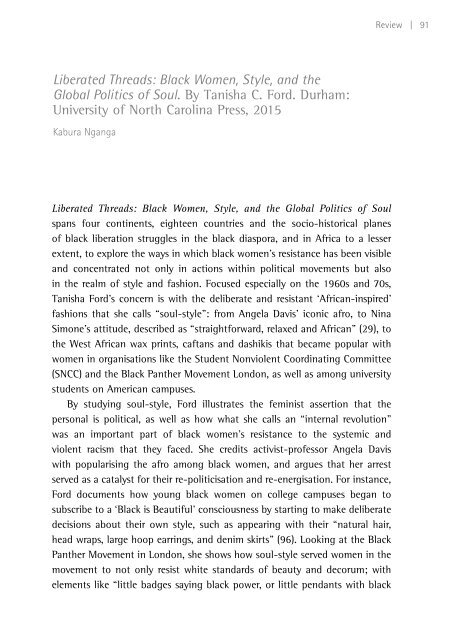The politics of fashion and beauty in Africa
fa21_proof_3
fa21_proof_3
You also want an ePaper? Increase the reach of your titles
YUMPU automatically turns print PDFs into web optimized ePapers that Google loves.
Review | 91<br />
Liberated Threads: Black Women, Style, <strong>and</strong> the<br />
Global Politics <strong>of</strong> Soul. By Tanisha C. Ford. Durham:<br />
University <strong>of</strong> North Carol<strong>in</strong>a Press, 2015<br />
Kabura Nganga<br />
Liberated Threads: Black Women, Style, <strong>and</strong> the Global Politics <strong>of</strong> Soul<br />
spans four cont<strong>in</strong>ents, eighteen countries <strong>and</strong> the socio-historical planes<br />
<strong>of</strong> black liberation struggles <strong>in</strong> the black diaspora, <strong>and</strong> <strong>in</strong> <strong>Africa</strong> to a lesser<br />
extent, to explore the ways <strong>in</strong> which black women’s resistance has been visible<br />
<strong>and</strong> concentrated not only <strong>in</strong> actions with<strong>in</strong> political movements but also<br />
<strong>in</strong> the realm <strong>of</strong> style <strong>and</strong> <strong>fashion</strong>. Focused especially on the 1960s <strong>and</strong> 70s,<br />
Tanisha Ford’s concern is with the deliberate <strong>and</strong> resistant ‘<strong>Africa</strong>n-<strong>in</strong>spired’<br />
<strong>fashion</strong>s that she calls “soul-style”: from Angela Davis’ iconic afro, to N<strong>in</strong>a<br />
Simone’s attitude, described as “straightforward, relaxed <strong>and</strong> <strong>Africa</strong>n” (29), to<br />
the West <strong>Africa</strong>n wax pr<strong>in</strong>ts, caftans <strong>and</strong> dashikis that became popular with<br />
women <strong>in</strong> organisations like the Student Nonviolent Coord<strong>in</strong>at<strong>in</strong>g Committee<br />
(SNCC) <strong>and</strong> the Black Panther Movement London, as well as among university<br />
students on American campuses.<br />
By study<strong>in</strong>g soul-style, Ford illustrates the fem<strong>in</strong>ist assertion that the<br />
personal is political, as well as how what she calls an “<strong>in</strong>ternal revolution”<br />
was an important part <strong>of</strong> black women’s resistance to the systemic <strong>and</strong><br />
violent racism that they faced. She credits activist-pr<strong>of</strong>essor Angela Davis<br />
with popularis<strong>in</strong>g the afro among black women, <strong>and</strong> argues that her arrest<br />
served as a catalyst for their re-politicisation <strong>and</strong> re-energisation. For <strong>in</strong>stance,<br />
Ford documents how young black women on college campuses began to<br />
subscribe to a ‘Black is Beautiful’ consciousness by start<strong>in</strong>g to make deliberate<br />
decisions about their own style, such as appear<strong>in</strong>g with their “natural hair,<br />
head wraps, large hoop earr<strong>in</strong>gs, <strong>and</strong> denim skirts” (96). Look<strong>in</strong>g at the Black<br />
Panther Movement <strong>in</strong> London, she shows how soul-style served women <strong>in</strong> the<br />
movement to not only resist white st<strong>and</strong>ards <strong>of</strong> <strong>beauty</strong> <strong>and</strong> decorum; with<br />
elements like “little badges say<strong>in</strong>g black power, or little pendants with black



